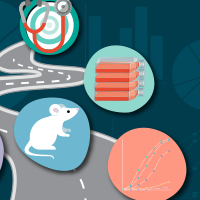Avoiding potential pitfalls in pre-clinical study design for cell and gene therapies
Cell & Gene Therapy Insights2019; 5(7), 1005–1009.
10.18609/cgti.2019.097
PODCAST Interview with Shawna M Jackman, Principal Research Scientist and the Scientific Lead for Charles River’s Cell & Gene Therapy Center of Excellence, and Lauren Black, Distinguished Scientist at Charles River.
Q You must have an interesting overview of the sort of errors that can be made in research that have repercussions for IND-enabling studies and beyond. Are there any examples you can provide of such pitfalls to which cell and gene therapy developers are prone?
Shawna: I don’t necessarily think there can ever be errors in research. I think all research experiments, by their nature, provide useful information to progress that therapy. The key goal in developing these cell and gene therapies is to really understand the nature of the product and any experiments or information that you can glean about how your product is going to function will always be beneficial to your programme.
However, some key considerations for developers of cell and gene therapies to help increase their chances of success would be to have very attainable expectations of how long the preclinical process may take. This also applies to the manufacturing process; it’s important to really understand their timelines for development, so they can plan accordingly.
Another beneficial step for developers is planning for the costs involved with these assessments, including any assays that are needed to detect their particular cells or gene product.
Lauren: Typically the cell and gene therapy developers are in a situation where they’re having to reinvent the drug development process every time. Because each product is so individual, they have to construct their plans from scratch, ones that are pertinent to their particular clinical population and their particular cell therapy. That’s a major challenge, having to customise the fundamental constructs of safety and efficacy testing over and over again from fundamental principles, every time you have a product.
Q Could you tell us about the sort of assistance that your average small cell and gene therapy biotech typically requires as it approaches IND-enabling studies?
Shawna: We find that many small cell and gene therapy biotech companies come to us not only for assistance in the design of their studies to meet regulatory requirements, but also for advice on how to navigate the regulatory process.
Cell and gene therapy biotech companies are experts in the mechanism of action of their product, such as how it’s going to work and what diseases it’s going to be used for. But a lot of the time, they rely on the scientists in the regulatory arena, such as the subject matter experts we have at Charles River, to really help guide them in the design and execution of the study.
The FDA specifically encourages developers of cell and gene therapy products to engage with them very early in the preclinical process, to make sure that any safety concerns for that product are being addressed in their preclinical programme. We work with developers from very early on to provide them with a strategy and to provide scientific guidance on the designs of their studies, so they can engage with the regulators early, to make sure they’re on the right path.
Lauren: We’re intensively involved in a lot of different consortia, including the Biosafe Working Group, where Shawna is the lead on the Cell Therapy Group. We’ve also worked with Cell and Gene Therapies at BIA. This means we have very good working relationships with the industry at large, and with the regulatory authorities.
Through these different efforts we stay tightly networked with all of our different stakeholders, and we always encourage our sponsors to reach out and attend these meetings with us to engage with regulatory authorities and scientific advice early on.
We have a good sense from 27 years working with these therapies how the packages should be designed and conducted. Nevertheless, we always ensure that our sponsors engage with current advice from the regulatory authorities before we actually run the studies. This helps de-risk their processes and ensure their timelines to starting IND are as rapid as possible.
Q To what extent is a bespoke approach to preclinical study design and execution a necessity in today’s cell and gene therapy arena, and how does this manifest in Charles River’s approach?
Shawna: For each cell and gene therapy, the preclinical process and the details of the preclinical programme are customised around the product attributes and indications for that particular product. At Charles River we are able to work with the client’s scientific expertise on the product they are developing and provide the guidance that they need for specific animal models, surgical models, or specific bio distribution end points they may have to evaluate. We not only provide the opportunity to perform those studies, but also the scientific guidance on which part of their programme needs to be customised in order to appropriately assess the safety of their product.
Lauren: It’s important to highlight that when we first encounter a programme and the sponsor brings it to us, that we go back into the details with them and discuss what they’ve already accomplished in their own laboratories. We try very hard not to repeat or cause redundancy in the programmes by looking at issues they’ve already addressed. What we want to do instead, is springboard off what has already been done, and then customise studies that exactly fit and add to the fundamental research that’s already in place.
Q Tell us more about the Charles River way, particularly as applied to novel and emerging technology fields. In particular, how do you seek to leverage the wealth of expertise across the organisation as a whole to benefit cell and gene therapy?
Shawna: At Charles River we have multiple subject matter experts in multiple fields. We find with cell and gene therapies that we really need to leverage all of that experience, because of the complexity of the programmes and the products.
We have established a cell and gene therapy Center of Excellence, which is a virtual hub where all of our expertise in cell and gene therapies can be centralised, and we can provide the scientific guidance that clients need.
This also serves as a scientific hub internally, where our scientists are able to share their experience and expertise in working with various products.
Lauren: One of the things I love about working here is we have many groups of experts that have different backgrounds and experience. I’ve had a chance to interact with folks from the research model groups, who were involved in raising and growing and characterising and phenotyping rare rodent models of disease. This research groups have experience in characterising the microbiome, characterising genetics, raising them from scratch from embryos, and re-cultivating lines that have long been in the freezer. We have experience of bringing into GMP settings animals that have previously only been studied in academic labs.
We’ve also really enjoyed working with our groups in Finland and North Carolina, who work on customised animal models of disease with neurology and cancer, respectively. Together, all of these different technologies have enabled us to do just about any kind of cell and gene therapy that’s currently on the planet, including CRISPR. It’s an exciting place and time to have all this collaboration.
Q Can you talk further about how and why Charles River seeks to keep the focus firmly on patients even at the preclinical stages, and do you have any illustrative examples you could share?
Lauren: I think the most important thing about clinical research and preclinical research is that there are patients out there who have an unmet medical needs.
We’ve been extremely active in networking with academic centers and with clinical programmes. There are two cases in the press right now: Mila Makovec and Jaci Hermstad at Boston Children’s Hospital and Colombia University, who have been treated with intrathecal antisense oligonucleotide. What we’ve done in those cases is network together with the families themselves and communicated with parents. We’ve also worked with the patient advocacy groups, which has helped us in our work with the clinical investigators in designing the clinical protocol.
For any kind of novel therapy, we’re going to have translational gaps and we’re going to have places where the clinical protocol needs to be especially enhanced to pick up the translational gaps. I think it’s absolutely required that we talk very carefully about what kinds of patients will be in the trials, exactly what their clinical conditions are, then design the non-clinical programme accordingly, in order to get the right balance between clinical and non-clinical.
Q The drive to reduce R&D timeframes is relentless across the board in pharma and biotech. Where do you see opportunities to ensure patients gain access to potentially lifesaving new therapies with minimal delays?
Shawna: At Charles River we provide services to pharma and biotech to move along their preclinical programmes as fast as possible. As part of this process, we need to make sure that the therapies are safe for the patient, and that the products are well characterised and understood.
We work with clients to make sure they have very well-designed studies that are streamlined, that can be conducted in the shortest time possible to get the answers that are needed, and also to expedite the reporting process and delivery of that data to the clients, so they can move forward with the regulatory process.
Q The immunotherapy area is particularly tricky in terms of gleaning reliable preclinical insights and predictions for the clinic. What can be done to address this challenge in this key field of cell and gene therapy?
Shawna: The field of immunotherapy is promising and we’re seeing some incredible results in the clinic in response to these therapies. However, the preclinical programmes for them can be quite challenging, because the animal models for these immunotherapy mechanisms can’t necessarily be delineated in the animal.
What we can do instead, is have a very good understanding of the cell and the manufacturing process itself. We know for all biologics, the process is the product. If we have a very tightly controlled manufacturing process, then we can have reliability that that product is being made in a consistent manner.
We demonstrate the efficacy of these immunotherapies in the in vivo preclinical programmes. We approach this by looking at hybrid efficacy/safety study designs, in order to get as much safety data as we can from these models.
Q What for you are the key considerations for preclinical study designs for rare diseases?
Shawna: The majority of cell and gene therapy programmes are being developed to treat rare diseases. Many of these diseases have absolutely no cure at the moment, and we have an opportunity with the regenerative medicine field to really provide the treatment that these patients need.
From the preclinical perspective, we want to get these products to these patients as fast as possible, but also in a safe and consistent manner. That’s why we at Charles River are very enthusiastic about assisting the developers of these products get the therapy to the patient.
Lauren: The field of gene therapy has shown us that recently we’ve had a lot of efficacy with AAV9s and other AAV vectors, in a way that’s not been possible before. These vectors have finally come to fruition and we’ve seen the actual approval of several cell and gene therapy products in the last 2 years. It’s so exciting, especially for someone who has been in this field as long as I have, to see these developments when they were floundering for a long time.
I think cure is not too strong a term. We’ve had recent successes, for instance, with Luxturna restoring vision in people that had not been able to see faces or stars.
We can design studies in a lot of ways, depending on the actual gene mutation behind these rare disorders. Sometimes we can actually recapitulate the patient in an animal model of disease and see the efficacy and toxicity in the very self-same model. When we get a chance to do that kind of really translational research, it’s very exciting as it helps progress the nonclinical and clinical trials as fast as possible when we can get that recapitulation of that activity and safety in the same species.
The FDA has been very progressive in allowing what can be described as generally minimalistic animal data, but we still insist on very strong pathology data, and look for all of the downsides that could occur in longer term testing. We need to look at long-term consequences of down regulating a physiological process that was due to a mutation in a rare disease.
Q What is your perception of how regulators’ preclinical data requirements are evolving, and will continue to evolve, as the cell and gene therapy field and its technologies mature further?
Shawna: The regulatory process for cell and gene therapies is very dynamic and the regulators work very closely with the developers of these therapies to make sure that the studies are going to be very streamlined and answer the questions that need to be answered.
We are seeing more of these products move forward to the clinic. We, as a CRO, are understanding more and more about what assays are needed. The regulators are seeing more and more products, and they’re very open about issuing multiple guidances to industry and having discussions with developers to make sure we are getting these products to the patients as fast as possible.
As the cell and gene therapy field continues to evolve, we are going to get more sophisticated in our techniques for detecting the cells or gene products of interest. We’re essentially going to have more understanding of how that product is going to interact, and we’re going to have more tools and technologies available to us in the preclinical in vivo stage, or in vitro stage, to be able to better characterise the products before they go into human trials.
Affiliations
Shawna M Jackman & Lauren Black
Charles River
This work is licensed under a Creative Commons Attribution- NonCommercial – NoDerivatives 4.0 International License.






